We’ve all dreamed of having a beautiful garden bursting with colorful blooms but felt intimidated by the thought of complex care routines and endless maintenance. The good news? You don’t need a green thumb or years of experience to create a stunning flower garden that’ll make your neighbors envious.
Growing flowers can be surprisingly simple when you choose the right varieties. Many gorgeous blooms actually thrive with minimal attention and can handle beginner mistakes with grace. From vibrant marigolds to cheerful sunflowers these hardy plants practically grow themselves once you get them started in the ground.
Whether you’re working with a sprawling backyard or a few small containers on your balcony we’ll show you exactly which flowers deliver maximum beauty with minimum effort. You’ll discover that creating your dream garden is easier than you ever imagined and more rewarding than you could expect.
Marigolds: The Ultimate Beginner-Friendly Blooms
Marigolds stand out as the perfect starter flower for new gardeners who want guaranteed success. These vibrant orange, yellow, and red blooms require minimal care while delivering maximum visual impact throughout the growing season.
Direct Seeding Made Simple
Plant marigold seeds directly in your garden soil for the easiest growing experience possible. We recommend sowing seeds after the last frost date when soil temperatures reach 60°F or warmer. Space seeds 6 to 8 inches apart and cover with just ¼ inch of soil since marigolds need light to germinate properly.
Germination occurs within 5 to 7 days under optimal conditions. Water gently every other day to keep soil moist but not waterlogged. Seedlings emerge quickly and grow rapidly once established. Thin overcrowded seedlings to ensure proper air circulation and prevent disease issues.
No special soil preparation is required for successful marigold cultivation. These adaptable flowers thrive in average garden soil with decent drainage. Add compost if your soil is particularly clay heavy or sandy, but marigolds tolerate various soil conditions without complaint.
Pest-Resistant Properties
Natural pest control comes built into every marigold plant through their pungent scent. We’ve observed that aphids, whiteflies, and other common garden pests actively avoid areas where marigolds grow. Their strong fragrance acts as a natural deterrent that protects both the marigolds and nearby plants.
Companion planting with marigolds benefits vegetable gardens significantly. Tomatoes, peppers, and beans grown near marigolds experience fewer pest problems. The chemical compounds in marigold roots also help suppress harmful nematodes in the soil.
Rabbits and deer typically avoid marigolds due to their bitter taste and smell. This makes them excellent border plants for gardens prone to wildlife damage. Plant marigolds around the perimeter of flower beds to create a natural barrier.
Long Blooming Season
Continuous flower production lasts from late spring until the first hard frost. We count on marigolds to provide color for 4 to 5 months in most climate zones. Regular deadheading encourages even more blooms and prevents the plants from going to seed too early.
Peak blooming occurs during summer months when temperatures stay consistently warm. French marigolds produce dozens of smaller flowers while African varieties showcase fewer but larger blooms. Both types maintain their vibrant colors even in intense heat and humidity.
Self-seeding capabilities ensure marigolds return year after year with minimal effort. Allow some flowers to go to seed at the end of the season and you’ll find volunteer seedlings the following spring. Collect dried seed heads in fall to start your own seeds indoors or share with fellow gardeners.
Zinnias: Colorful Flowers That Thrive With Minimal Care
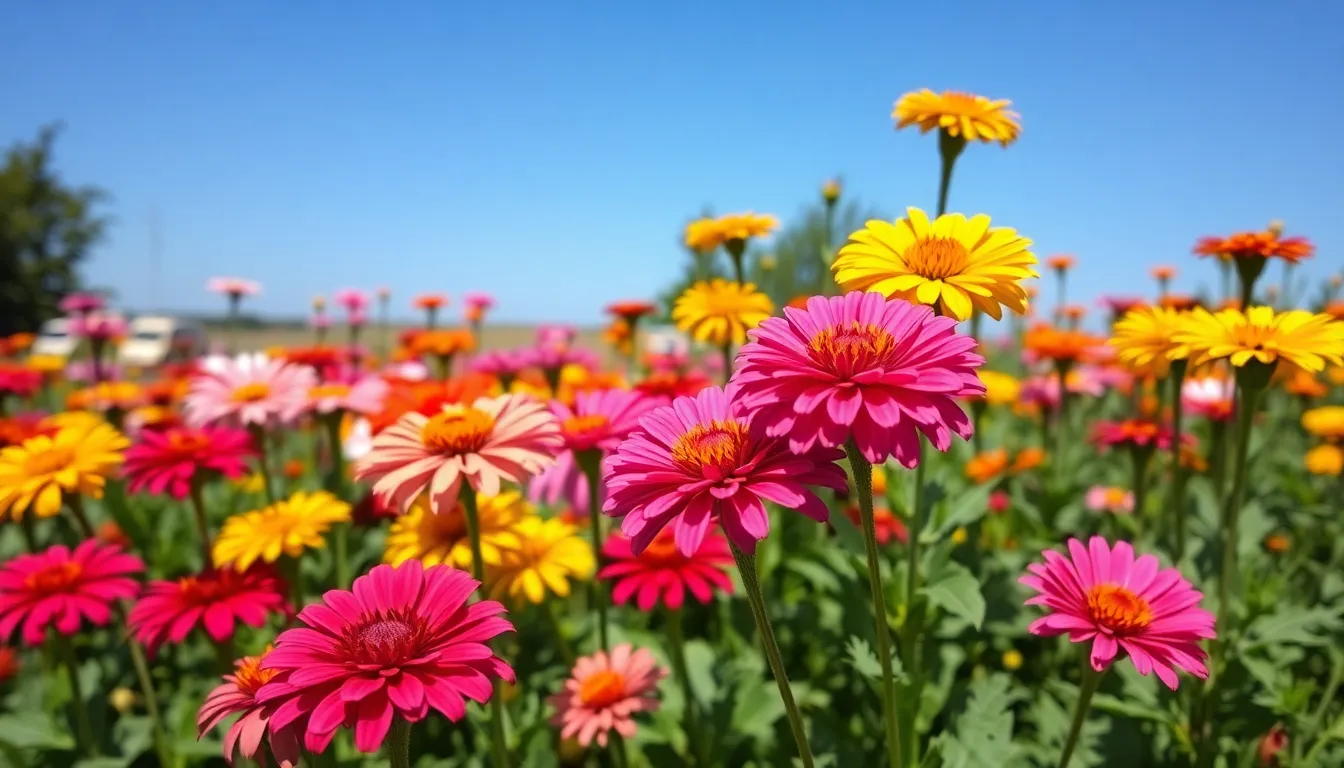
Zinnias offer vibrant blooms with remarkably little effort, making them perfect companions to marigolds in our easy care flower garden. These resilient flowers adapt to challenging conditions while delivering stunning visual impact throughout the growing season.
Heat and Drought Tolerance
Zinnias excel in warm climates where other flowers struggle to survive. These robust blooms tolerate high temperatures and dry conditions once they’re established in your garden. Water them deeply a few times per week during their early growth stage, keeping soil moist 6 to 8 inches deep to encourage strong root development.
Established zinnia plants show impressive drought resistance, requiring less frequent watering than many garden favorites. Their heat tolerance makes them ideal for sunny locations that receive at least six hours of direct sunlight daily. We recommend avoiding overwatering, as excess moisture can lead to root rot and fungal diseases that damage these otherwise hardy flowers.
Continuous Cutting for Bouquets
Zinnias reward regular cutting with increased flower production throughout the growing season. Snipping blooms for indoor arrangements actually encourages the plants to produce more flowers rather than setting seed. This cut and come again habit makes zinnias perfect for gardeners who enjoy fresh bouquets in their homes.
Deadheading spent flowers serves the same purpose when you’re not harvesting blooms for arrangements. Removing faded flowers redirects the plant’s energy into creating new buds instead of seed production. Regular maintenance like this keeps your zinnia plants blooming continuously from late spring until the first hard frost arrives.
Variety of Sizes and Colors
Zinnias come in an impressive range of sizes from compact 6 inch varieties to towering 4 foot giants. Dwarf types work beautifully in containers and border edges, while tall varieties create stunning backdrops in flower beds. Medium sized zinnias fill the middle ground perfectly, offering versatility for various garden designs.
Color options span the entire spectrum except blue, giving us choices from soft pastels to bold, saturated hues. Popular varieties include bright oranges, deep reds, sunny yellows, and pristine whites that complement any garden color scheme. Bicolor and striped varieties add extra visual interest, while single and double flower forms provide different textures and appearances in our plantings.
Sunflowers: Giant Blooms With Simple Growing Requirements
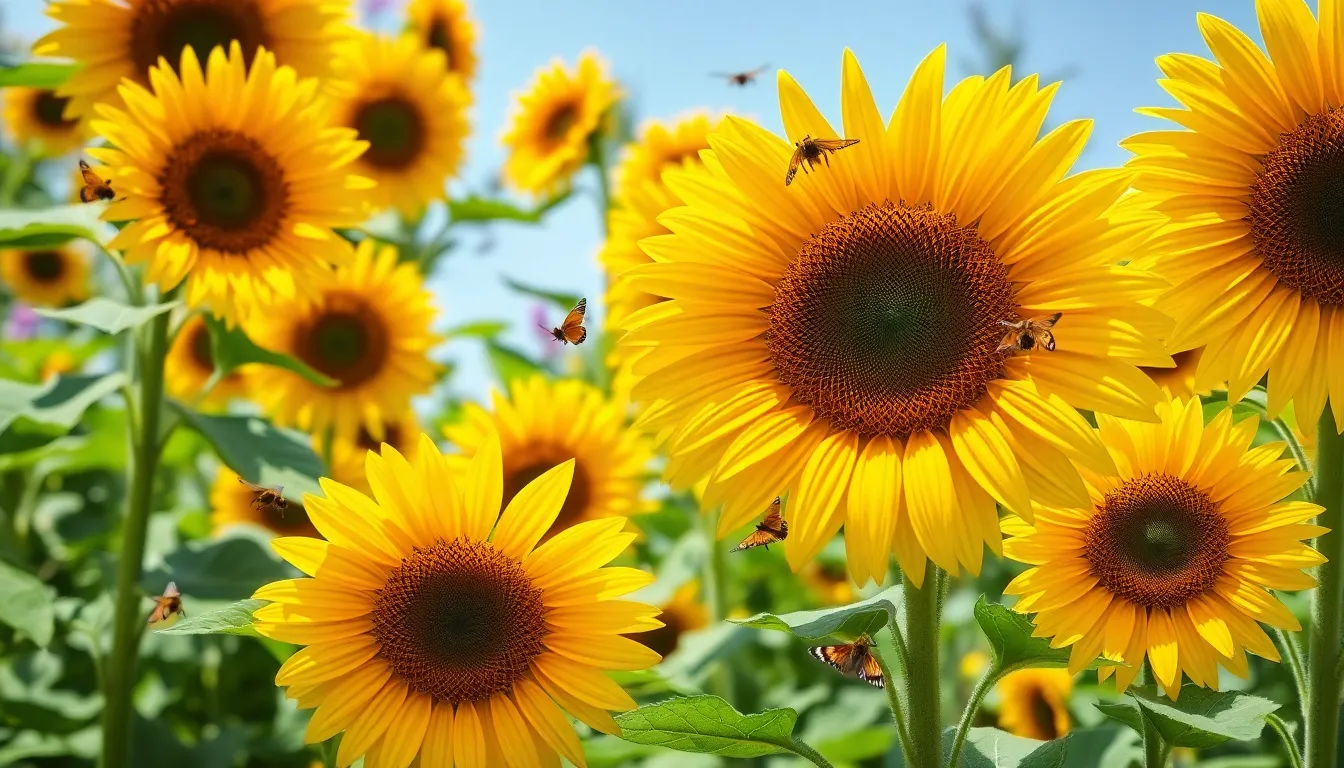
Sunflowers bring towering beauty to our gardens while requiring minimal effort from us gardeners. These annual giants thrive in full sun and most soil types, making them perfect additions to our easy care flower collection.
Fast-Growing Nature
Sunflowers grow remarkably quickly from seed to full bloom in just one growing season. We can plant seeds directly in our garden soil after the last frost date and watch them germinate within 7 to 14 days. These impressive flowers reach their full height of 6 to 12 feet in approximately 80 to 120 days from planting. Direct seeding works best since sunflowers develop long taproots that don’t transplant well. We’ll see rapid growth throughout the summer months as these vigorous plants establish themselves in our gardens.
Minimal Water Needs
Sunflowers demonstrate excellent drought tolerance once they’re established in our gardens. We need to water them regularly during the first few weeks after planting to help seedlings develop strong root systems. Once mature, these hardy flowers require watering only during extended dry periods. Deep watering once or twice a week works better than frequent shallow watering since it encourages the development of strong root systems. Their natural drought resistance makes sunflowers ideal for water conscious gardeners who want beautiful blooms without constant irrigation.
Attracting Beneficial Wildlife
Sunflowers serve as magnets for beneficial creatures in our gardens throughout their growing season. Bees visit the large flower heads regularly to collect nectar and pollen, supporting local pollinator populations. Birds, particularly finches and cardinals, flock to mature sunflower heads to feast on the nutrient rich seeds. Butterflies also frequent these giant blooms, adding movement and color to our garden spaces. We can leave spent flower heads on the plants in fall to provide natural bird feeding stations, extending the wildlife benefits well beyond the growing season.
Cosmos: Delicate-Looking Flowers With Hardy Growth Habits
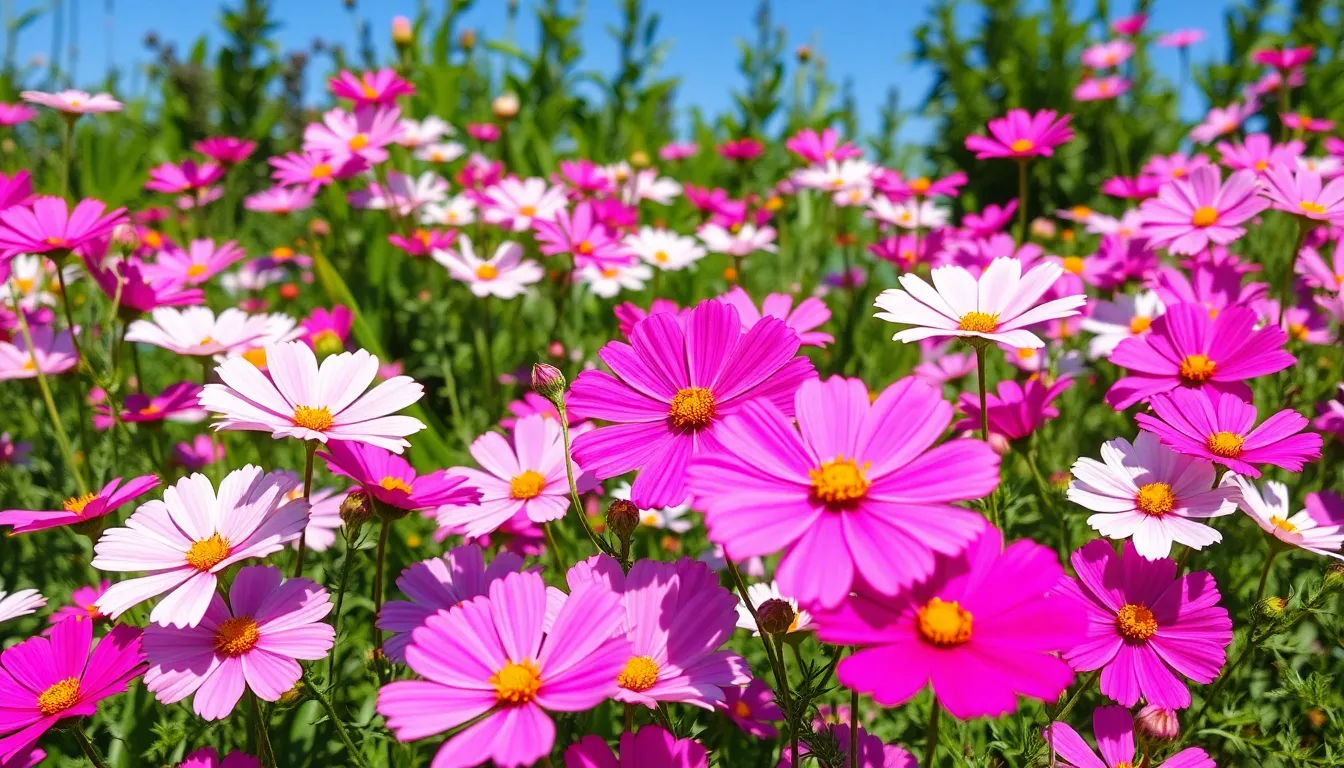
Don’t let cosmos’ papery petals and feathery foliage fool you into thinking they’re fragile garden additions. These resilient beauties combine ethereal appearance with robust growing habits that make them perfect for novice gardeners.
Self-Seeding Capabilities
Self-seeding makes cosmos one of nature’s most generous performers in our gardens. Once established, these flowers drop their seeds naturally at the end of each growing season, creating new plants the following year without any effort from us. We’ll find cosmos seedlings emerging in spring from the exact spots where parent plants grew, ensuring continuous blooms year after year.
Volunteer plants often appear in unexpected garden locations where seeds have traveled on the wind or been carried by birds. These surprise cosmos additions typically grow stronger than their parents since they’ve naturally selected the best growing conditions for themselves. We can easily transplant these volunteers to desired locations while they’re still small, giving us free plants to expand our flower displays.
Poor Soil Tolerance
Poor soil conditions actually benefit cosmos more than rich, fertile ground. These adaptable flowers thrive in average to poor soils that would challenge many other garden plants, making them ideal for difficult growing areas. We’ve found that cosmos grown in nutrient-poor soil develop stronger root systems and produce more abundant blooms than those pampered in rich garden beds.
Clay soil, sandy soil, and even slightly alkaline conditions won’t deter cosmos from flourishing in our gardens. They require minimal soil preparation beyond basic drainage, eliminating the need for expensive soil amendments or fertilizers. Overly fertile soil can actually cause cosmos to produce excessive foliage at the expense of flower production, proving that sometimes less is more in gardening.
Extended Flowering Period
Extended blooming keeps cosmos colorful in our gardens from early summer through the first hard frost. These reliable performers begin flowering approximately 60 to 70 days after planting and continue producing new blooms for months without requiring deadheading or special care. We appreciate how cosmos maintain their flower production even during hot summer weather when many other annuals struggle or stop blooming.
Regular cutting for bouquets encourages even more prolific flowering, making cosmos excellent dual-purpose plants for both garden display and indoor arrangements. Their extended flowering period overlaps perfectly with the blooming seasons of marigolds, zinnias, and sunflowers, creating layered color combinations that last throughout the growing season. Late-season cosmos flowers often display deeper, more intense colors as cooler autumn temperatures arrive, providing beautiful contrast to early fall foliage.
Nasturtiums: Edible Flowers That Grow Almost Anywhere
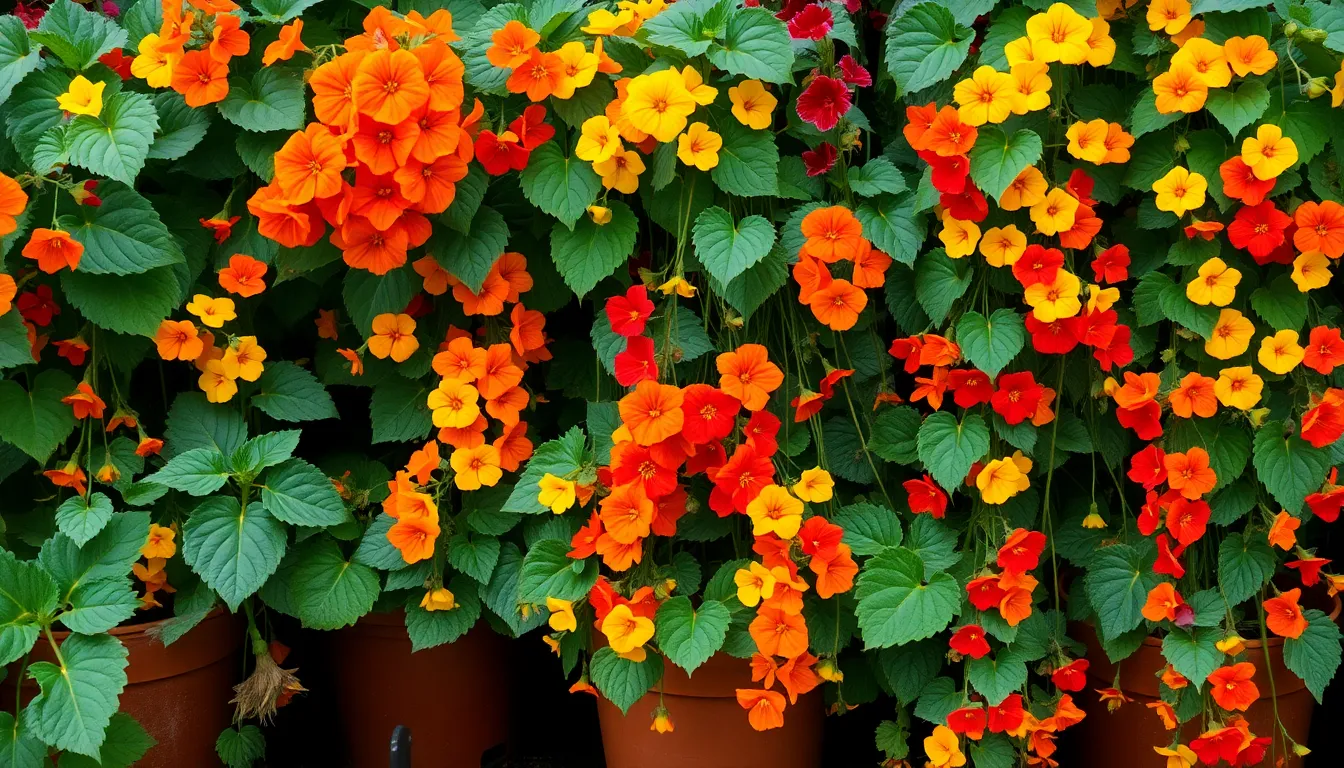
Nasturtiums bring vibrant color and unique peppery flavor to our gardens while requiring minimal care to thrive. These versatile flowers adapt to various growing conditions and provide both beauty and culinary benefits throughout the growing season.
Climbing and Trailing Varieties
Climbing varieties transform vertical spaces into colorful displays when we train them up trellises or garden supports. These vigorous growers create natural screens and add decorative elements to fences, arbors, and pergolas with their abundant blooms.
Trailing varieties excel in hanging baskets where their cascading stems create stunning waterfall effects of color. We can also use these spreading types to soften hard edges along walls, containers, and garden borders. Their flexible growth habit makes them perfect for spilling over retaining walls or filling gaps between taller plants.
Both growth forms produce the same edible flowers and pest deterrent benefits while offering different design possibilities for our garden spaces.
Natural Pest Deterrent Properties
Nasturtiums repel aphids, whiteflies, and other common garden pests through their natural chemical compounds. We can plant them as companion plants near vegetables like tomatoes, cucumbers, and beans to create a protective barrier against harmful insects.
Their strong scent confuses pest insects and draws them away from more valuable crops in our vegetable gardens. Many organic gardeners rely on nasturtiums as a natural alternative to chemical pesticides for protecting their harvest.
These beneficial properties work continuously throughout the growing season without any additional effort from us gardeners.
Culinary Uses and Benefits
Nasturtium flowers deliver a peppery, spicy flavor similar to watercress that adds zest to fresh salads and garnishes. We can harvest both the colorful blooms and young leaves to incorporate into our cooking throughout the summer months.
Fresh flowers work beautifully as edible garnishes on soups, sandwiches, and appetizer plates, providing both visual appeal and unique taste. Pickling the flower buds creates a caper-like condiment that stores well for months.
Nutritional benefits include high levels of vitamins A, C, and K along with beneficial antioxidants that support our health. These edible flowers contain more vitamin C per serving than many traditional leafy greens, making them a nutritious addition to our diet.
We can harvest nasturtium flowers and leaves continuously from late spring through the first frost, ensuring a steady supply of fresh, edible blooms for our kitchen.
Calendulas: Cool-Weather Flowers Easy to Grow Year-Round
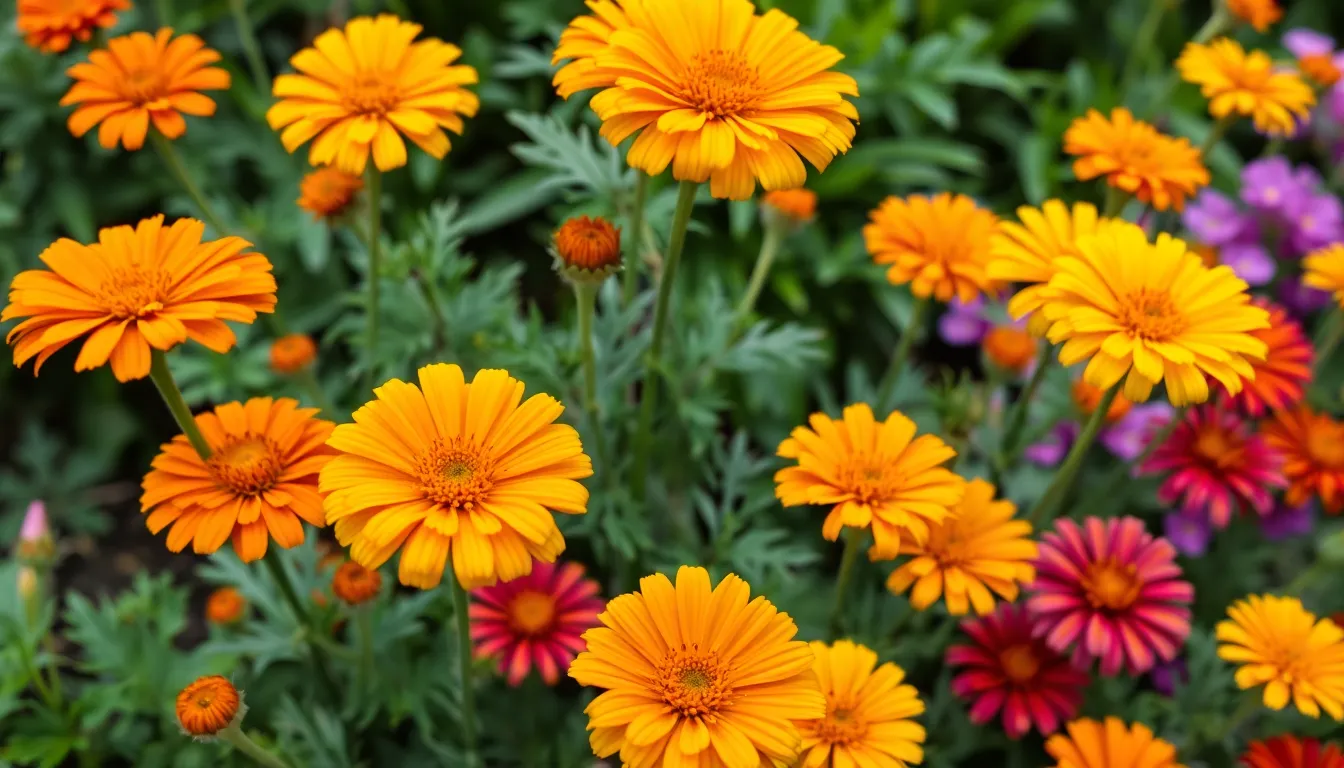
Calendulas stand apart from other easy flowers by thriving in cooler temperatures when most blooms struggle. We recommend these hardy annuals for gardeners seeking year-round color with minimal maintenance requirements.
Cold Tolerance Advantages
Cool weather brings out the best in calendula performance, unlike heat-loving flowers that wilt in autumn temperatures. These resilient annuals flourish in USDA zones 9 and 10, where they bloom continuously from late winter through spring before summer heat causes decline.
Seeds germinate quickly in just 7 to 14 days, making calendulas perfect for novice gardeners who want fast results. We can start them indoors 6 to 8 weeks before the last frost for early spring displays or direct sow in mid to late summer for autumn blooms.
Winter survival becomes possible in mild climates where calendulas may overwinter naturally to bloom again in spring. Indoor overwintering works well in colder regions when we maintain bright light conditions at 70 to 75°F temperatures.
Frost tolerance isn’t their strength, but calendulas prefer cooler conditions that would stress other annual flowers. Their adaptability to sun or partial shade locations gives us flexibility in garden placement throughout different seasons.
Medicinal and Cosmetic Uses
Antioxidant-rich calendula flowers offer remarkable healing properties that extend their garden value beyond ornamental appeal. These blooms increase blood flow to affected skin areas while suppressing infections, making them historically valuable for treating wounds, rashes, and burns.
Commercial applications include calendula extracts in diaper creams, natural lotions, and first-aid preparations due to their proven antimicrobial and skin-nourishing qualities. We can harvest fresh petals to create homemade skincare preparations or dry them for long-term storage.
Natural food coloring becomes achievable using dried calendula petals, which safely add golden hues to various dishes. Chicken keepers benefit from adding dried petals to feed, resulting in darker, more vibrant egg yolks from their flocks.
Harvesting opportunities continue throughout the growing season as calendulas produce new blooms regularly when we maintain proper care routines.
Succession Planting Tips
Continuous blooms require strategic succession planting every few weeks from spring through fall to maintain constant garden color. We achieve the longest flowering display by staggering seed sowings rather than planting everything at once.
Spring sowings provide early season color while mid-summer plantings ensure autumn blooms when other flowers fade. Multiple planting dates create overlapping bloom periods that extend the calendula show from spring through winter in favorable climates.
Companion planting works exceptionally well with fruit trees and early vegetables since calendulas attract beneficial pollinators to the garden. Their drought-resistant nature means succession plantings won’t strain our watering schedule or garden maintenance routine.
Self-seeding capabilities develop when we allow some flowers to go to seed naturally, creating volunteer plants for the following season without additional planting effort.
Morning Glories: Fast-Growing Vines With Spectacular Blooms
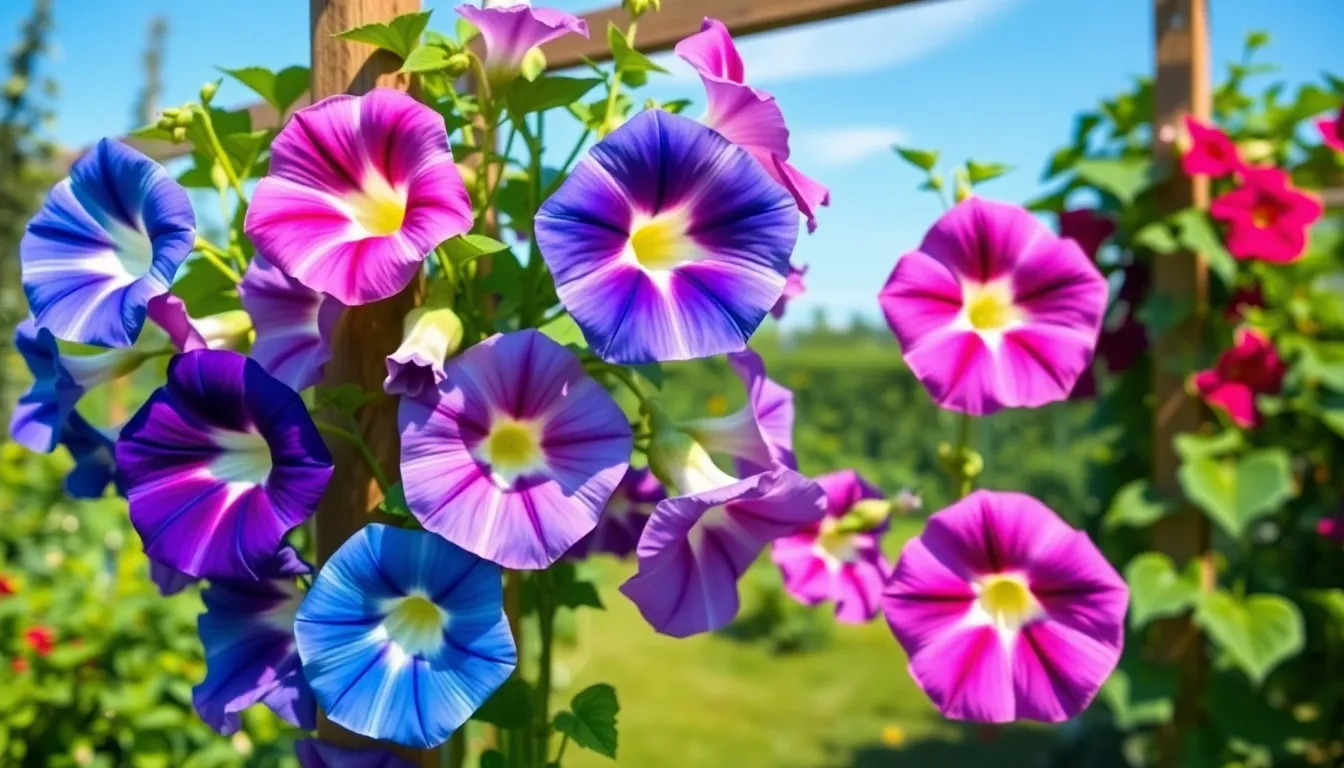
Morning glories deliver the perfect combination of rapid growth and stunning beauty that we’ve been seeking for vertical garden spaces. These vigorous climbing vines produce large trumpet-shaped flowers in vibrant shades of blue, purple, pink, white, and striking bi-colors that open each morning to create daily garden magic.
Rapid Coverage for Fences and Walls
Vigorous growth makes morning glories exceptional choices for quickly transforming bare vertical surfaces into lush green backdrops. These climbing champions can cover fences, trellises, and walls with remarkable speed, providing instant privacy screens and decorative garden features within a single growing season.
Natural screening develops as the dense foliage creates effective barriers that block unsightly views while adding vertical interest to our garden design. The vines climb aggressively upward, reaching impressive heights that turn mundane structures into living art installations.
Vertical transformation occurs rapidly as morning glories establish themselves and begin their climbing journey. We can expect these energetic vines to completely cover a 6-foot fence or trellis within just a few months of planting, making them ideal for gardeners who want immediate results.
Minimal Fertilizer Requirements
Average soil conditions suit morning glories perfectly, as these adaptable vines thrive without heavy fertilization or soil amendments. We’ll find that excessive fertilizer actually works against us, promoting abundant foliage growth at the expense of those spectacular blooms we’re after.
Poor soil tolerance makes morning glories forgiving choices for challenging garden locations where other plants might struggle. These hardy vines adapt well to less-than-perfect growing conditions, requiring only well-drained soil and full sun to produce their best performance.
Low maintenance feeding becomes our gardening advantage since morning glories prefer minimal nutritional input. A single application of balanced fertilizer at planting time provides sufficient nutrients for the entire growing season, allowing us to focus our gardening energy elsewhere.
Self-Seeding for Next Year
Natural seed production occurs after the morning glory blooms fade, creating seed pods that mature and drop seeds automatically at season’s end. This self-perpetuating cycle means we can enjoy these beautiful vines year after year without replanting efforts or seed purchasing.
Sustainable gardening becomes effortless as dropped seeds germinate naturally the following spring, creating new plants exactly where we want them. The seeds overwinter in the soil and sprout when conditions become favorable, maintaining our vertical garden displays with zero intervention.
Effortless renewal happens as morning glories establish themselves as permanent garden fixtures through their reliable self-seeding habit. We can count on fresh vines appearing each growing season, though we may need to thin seedlings if they become too abundant in our preferred planting areas.
Sweet Alyssum: Fragrant Ground Cover Flowers
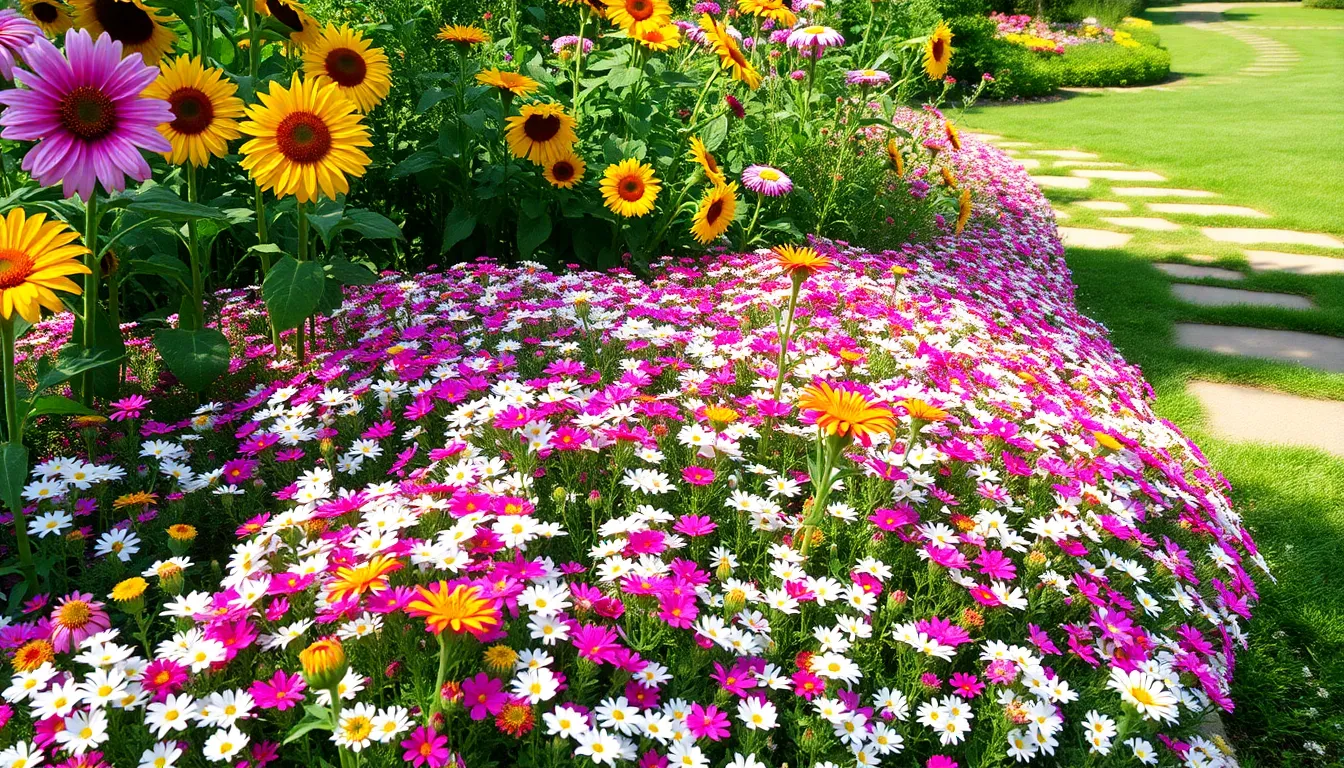
Sweet alyssum transforms garden spaces with its delicate honey-scented blooms and low-maintenance growing habits. We’ve discovered this annual creates stunning results when planted as living mulch between taller flowers like sunflowers and zinnias.
Carpet-Like Growth Pattern
Sweet alyssum spreads naturally to form dense, uniform mats that suppress weeds effectively. The plants grow only 3 to 6 inches tall while spreading 6 to 12 inches wide, creating perfect ground coverage for bare spots in our flower beds. Dense clusters of tiny white, pink, or purple flowers blanket the entire plant surface from spring until frost. We can plant sweet alyssum seeds directly in garden soil, and they’ll germinate within 5 to 10 days under optimal conditions. Regular watering during establishment helps create the thick carpet effect we’re looking for in ground cover applications.
Tolerance for Light Foot Traffic
Sweet alyssum handles occasional stepping better than most delicate ground covers, making it practical for pathway edges and garden borders. The flexible stems bend rather than break when lightly compressed, allowing the plants to recover quickly from minor disturbances. We recommend using sweet alyssum along garden walkways where people might occasionally step off the main path. But, it’s not suitable for heavy foot traffic areas like main walkways or children’s play spaces. Planted between stepping stones, sweet alyssum creates a living carpet that tolerates the light pressure from occasional footsteps.
Attractive to Beneficial Insects
Sweet alyssum draws beneficial insects including hover flies, parasitic wasps, and lacewings that help control garden pests naturally. The tiny flowers produce easily accessible nectar that feeds small beneficial insects throughout the growing season. We’ve observed that planting sweet alyssum near vegetable gardens increases populations of pest-controlling insects by up to 40%. Bees visit sweet alyssum regularly, making it an excellent pollinator plant for gardens focused on supporting local bee populations. The extended blooming period from spring through fall provides consistent food sources for beneficial insects when other flowers may not be available.
Four O’Clocks: Evening Bloomers With Effortless Care
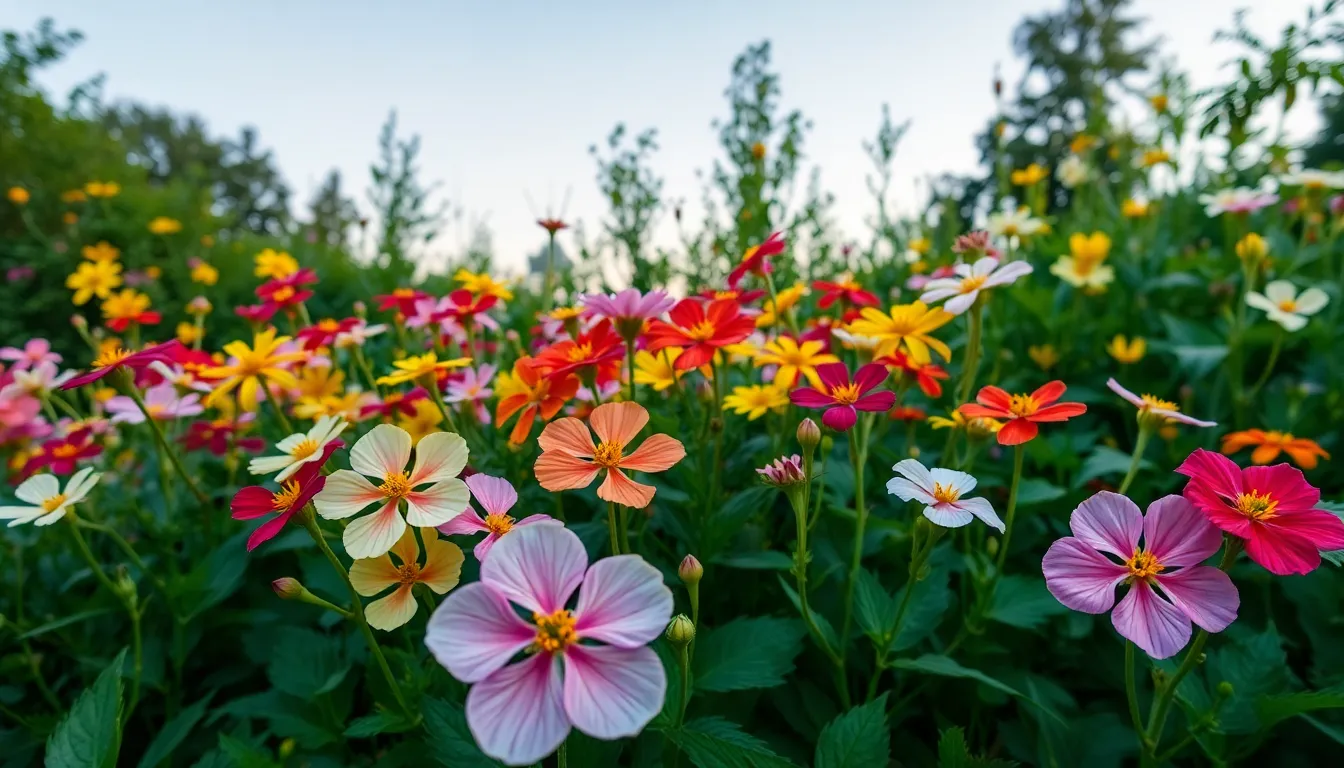
Four O’Clocks (Mirabilis jalapa) offer gardeners the perfect combination of stunning blooms and minimal maintenance requirements. These remarkable flowers open their colorful petals in late afternoon and evening, creating a magical display when other flowers are closing for the day.
Heat and Humidity Resistance
Four O’Clocks excel in challenging weather conditions that often stress other flowering plants. These hardy annuals thrive in full sun exposure and can tolerate temperatures that reach extreme levels during summer months. Humidity levels that cause problems for more delicate flowers don’t affect Four O’Clocks, making them ideal choices for hot, sticky climates.
We’ve found these plants maintain their vibrant appearance even during heat waves that can last several weeks. Their natural resilience means they require less frequent watering than most garden flowers once established. Generally, they’re pest resistant with only occasional issues from aphids or spider mites, which respond well to simple insecticidal soap treatments.
Tuberous Root Storage
Four O’Clocks develop tuberous roots that act as natural storage systems for nutrients and water. In USDA zones 9 through 11, these perennial plants regrow from their underground tubers each spring without any intervention from gardeners. Colder climate gardeners can dig up the tubers in fall and store them indoors through winter months.
Tuber storage requires minimal effort and provides guaranteed plants for the following season. We recommend storing tubers in slightly moist peat moss or sand in a cool, dark location around 45 to 50 degrees Fahrenheit. Alternatively, Four O’Clocks readily self seed, dropping viable seeds that germinate naturally when conditions become favorable.
Fragrant Evening Display
Four O’Clocks create their most spectacular show during evening hours when their trumpet shaped flowers open wide. These blooms release intense fragrances that attract evening pollinators like moths and hummingbirds to the garden. Plants typically grow about 3 feet tall and wide, creating substantial displays that fill garden spaces with color and scent.
Blooming continues from late afternoon through early morning hours, providing extended enjoyment during prime outdoor relaxation times. Different varieties offer flowers in vibrant yellows, deep reds, bright pinks, pure whites, and striking bicolors. Their reliable evening performance makes them perfect companions for outdoor dining areas and evening garden strolls.
Bachelor’s Buttons: Cottage Garden Favorites Made Easy
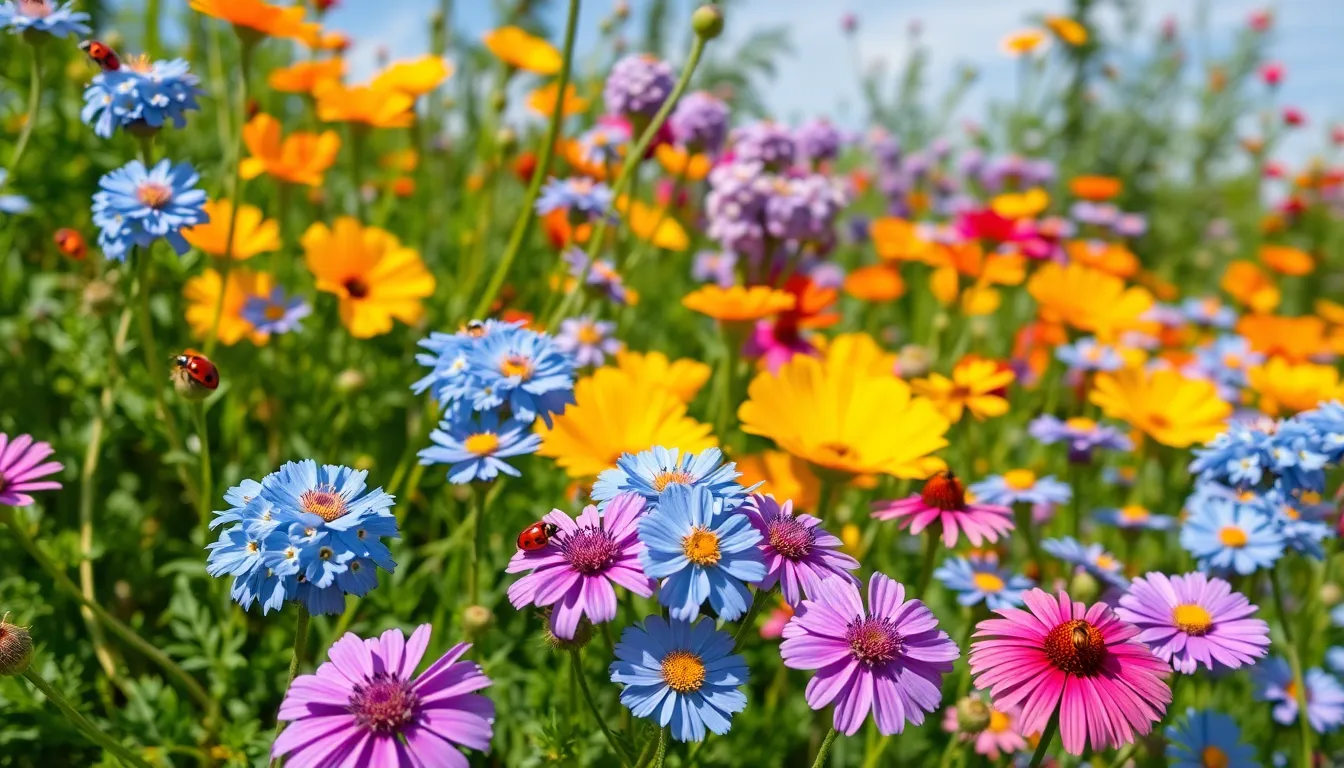
Bachelor’s Buttons bring timeless charm to our gardens while demanding minimal effort from us. These delightful blooms thrive in temperatures between 60°F and 80°F, making them perfect companions to our other easy care flowers.
Self-Seeding Annual Benefits
Self seeding makes Bachelor’s Buttons incredibly low maintenance for our gardens. We’ll watch these charming flowers naturally reappear each year without replanting efforts, dropping their seeds at season’s end to create next year’s display. Beneficial insects like ladybugs flock to these blooms, helping us control garden pests naturally through companion planting strategies.
Seeds germinate within 7 to 14 days when we provide well draining soil and consistent moisture. We can direct sow them into our garden beds or start them indoors for transplantation, giving us flexibility based on our gardening preferences. Soil temperatures of at least 55°F ensure successful germination alongside our other spring planted annuals.
Companion planting with Bachelor’s Buttons attracts helpful predatory insects that protect our entire garden network. We’ll find these flowers work beautifully when naturalized with California poppies and cosmos, creating pollinator friendly areas that support beneficial wildlife. Their wiry stems and hardy nature make them excellent choices for low maintenance garden sections.
Cut Flower Longevity
Cut flowers from Bachelor’s Buttons last an impressive 6 to 10 days in our vases when harvested properly. We should cut these blooms just as they begin to open for maximum vase life and optimal appearance. Fresh arrangements benefit from their delicate texture and vibrant colors throughout the week.
Summer bouquets gain delightful character when we include these cottage garden favorites alongside our other homegrown blooms. Regular cutting encourages more flower production, rewarding us with continuous harvests for indoor arrangements. We can create stunning mixed bouquets by combining Bachelor’s Buttons with our zinnias, cosmos, and other easy care flowers.
Historical Garden Significance
Historical use of Bachelor’s Buttons includes traditional boutonnieres and formal floral arrangements dating back generations. We know these flowers by several names including Cornflowers and Hurt Sickle, reflecting their cultural importance and distinctive wiry stems. Their presence in cottage gardens represents timeless appeal that connects us to gardening traditions.
Naturalized gardens benefit from Bachelor’s Buttons’ ability to attract pollinators while adding authentic cottage garden character. We can incorporate them into heritage garden designs where they complement other self seeding annuals perfectly. Their historical significance as companion plants makes them valuable additions to our vegetable gardens, where they’ve traditionally helped control pests naturally.
Conclusion
We’ve shown you that creating a stunning flower garden doesn’t require years of experience or specialized knowledge. These ten easy-to-grow varieties will transform your outdoor space with minimal effort and maximum reward.
From marigolds’ pest-fighting power to morning glories’ rapid vertical coverage each flower brings unique benefits while demanding little from busy gardeners. Whether you’re working with containers or acres of land these resilient bloomers adapt to your space and schedule.
Start with just two or three varieties that speak to you. Plant them this season and watch your confidence grow alongside your beautiful blooms. Your garden success story begins with that first simple step.
Frequently Asked Questions
What are the easiest flowers to grow for beginners?
Marigolds, zinnias, sunflowers, cosmos, nasturtiums, calendulas, morning glories, sweet alyssum, Four O’Clocks, and Bachelor’s Buttons are the easiest flowers for beginners. These varieties require minimal maintenance, are forgiving of poor soil conditions, and many self-seed for effortless renewal each year.
How do I start a flower garden with no experience?
Start by choosing easy-care flowers like marigolds and zinnias that thrive in average soil conditions. Direct seed them in your garden space following package directions for timing and spacing. These beginner-friendly flowers germinate quickly and require minimal special preparation or gardening knowledge.
What flowers require the least maintenance?
Cosmos, marigolds, and calendulas require the least maintenance. They self-seed, thrive in poor soil, need minimal watering once established, and don’t require deadheading. These hardy flowers bloom continuously from spring through frost with virtually no care needed.
How long do easy-care flowers bloom?
Most easy-care flowers bloom from late spring until the first hard frost, providing 4-6 months of continuous color. Marigolds, zinnias, cosmos, and nasturtiums all have extended flowering periods that overlap throughout the growing season, ensuring constant garden color with minimal effort.
Can I grow flowers in containers if I don’t have a yard?
Yes, many easy-care flowers like marigolds, zinnias, and nasturtiums grow excellently in containers. Choose compact varieties and ensure proper drainage. Container gardening allows you to create beautiful flower displays on patios, balconies, or small spaces without needing a traditional garden bed.
Do easy-care flowers attract beneficial insects?
Yes, flowers like sunflowers, cosmos, calendulas, and sweet alyssum attract bees, butterflies, and other beneficial insects. These pollinators help your garden ecosystem while also controlling harmful pests naturally. Many easy-care flowers serve dual purposes as pest deterrents and pollinator magnets.
What flowers can I eat from my garden?
Nasturtiums offer edible flowers and leaves with a peppery flavor, perfect for salads and garnishes. Calendulas are also edible and have medicinal properties. Always verify flower varieties are safe for consumption and avoid treated flowers when harvesting for culinary use.
How do self-seeding flowers work?
Self-seeding flowers like cosmos, morning glories, and Four O’Clocks drop their seeds naturally at season’s end. These seeds germinate the following spring without replanting effort. This creates a sustainable garden cycle where flowers return annually with no additional work from gardeners.







